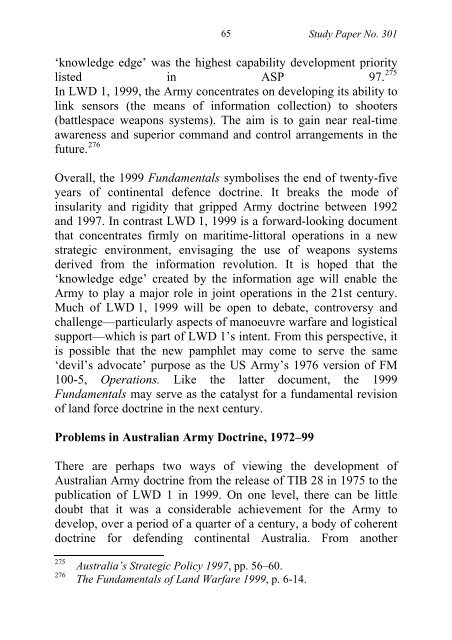Ibid - Australian Army
Ibid - Australian Army
Ibid - Australian Army
Create successful ePaper yourself
Turn your PDF publications into a flip-book with our unique Google optimized e-Paper software.
65<br />
Study Paper No. 301<br />
‘knowledge edge’ was the highest capability development priority<br />
listed in ASP 97. 275<br />
In LWD 1, 1999, the <strong>Army</strong> concentrates on developing its ability to<br />
link sensors (the means of information collection) to shooters<br />
(battlespace weapons systems). The aim is to gain near real-time<br />
awareness and superior command and control arrangements in the<br />
future. 276<br />
Overall, the 1999 Fundamentals symbolises the end of twenty-five<br />
years of continental defence doctrine. It breaks the mode of<br />
insularity and rigidity that gripped <strong>Army</strong> doctrine between 1992<br />
and 1997. In contrast LWD 1, 1999 is a forward-looking document<br />
that concentrates firmly on maritime-littoral operations in a new<br />
strategic environment, envisaging the use of weapons systems<br />
derived from the information revolution. It is hoped that the<br />
‘knowledge edge’ created by the information age will enable the<br />
<strong>Army</strong> to play a major role in joint operations in the 21st century.<br />
Much of LWD 1, 1999 will be open to debate, controversy and<br />
challenge—particularly aspects of manoeuvre warfare and logistical<br />
support—which is part of LWD 1’s intent. From this perspective, it<br />
is possible that the new pamphlet may come to serve the same<br />
‘devil’s advocate’ purpose as the US <strong>Army</strong>’s 1976 version of FM<br />
100-5, Operations. Like the latter document, the 1999<br />
Fundamentals may serve as the catalyst for a fundamental revision<br />
of land force doctrine in the next century.<br />
Problems in <strong>Australian</strong> <strong>Army</strong> Doctrine, 1972–99<br />
There are perhaps two ways of viewing the development of<br />
<strong>Australian</strong> <strong>Army</strong> doctrine from the release of TIB 28 in 1975 to the<br />
publication of LWD 1 in 1999. On one level, there can be little<br />
doubt that it was a considerable achievement for the <strong>Army</strong> to<br />
develop, over a period of a quarter of a century, a body of coherent<br />
doctrine for defending continental Australia. From another<br />
275<br />
276<br />
Australia’s Strategic Policy 1997, pp. 56–60.<br />
The Fundamentals of Land Warfare 1999, p. 6-14.

















